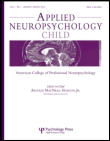
Applied Neuropsychology-Child
Scope & Guideline
Transforming child neuropsychology with impactful research.
Introduction
Aims and Scopes
- Neurodevelopmental Disorders:
Research on the assessment and intervention of neurodevelopmental disorders such as ADHD, autism spectrum disorders, and learning disabilities, focusing on their cognitive and behavioral profiles. - Cognitive Functioning:
Studies evaluating cognitive functions including executive function, memory, and processing speed, particularly in pediatric populations with various clinical conditions. - Assessment Tools and Methodologies:
Development and validation of neuropsychological assessment tools tailored for children, ensuring cultural relevance and clinical utility. - Intervention Strategies:
Exploration of therapeutic interventions, including cognitive training, behavioral therapies, and innovative techniques like neurofeedback and video games, aimed at improving cognitive and executive functions. - Longitudinal and Cross-Sectional Studies:
Research employing both longitudinal and cross-sectional methodologies to understand the developmental trajectories of cognitive and emotional functioning in children. - Impact of Medical Conditions:
Investigating the neuropsychological impact of medical conditions such as pediatric cancer, traumatic brain injury, and neurological disorders on children's cognitive and emotional development.
Trending and Emerging
- Neuropsychological Impact of Medical Conditions:
There is an increasing focus on understanding the neuropsychological effects of medical conditions such as cancer and traumatic brain injury, reflecting a growing recognition of the need for integrated care in pediatric populations. - Innovative Assessment Technologies:
Emerging methodologies, including digital assessments and neurofeedback, are gaining popularity, indicating a trend towards leveraging technology to enhance cognitive assessment and intervention. - Executive Functioning Research:
A significant increase in studies exploring executive functions, particularly in diverse clinical populations, showcases a trend towards understanding the complexities of cognitive control and its implications for learning. - Interventions Targeting Emotional and Behavioral Regulation:
The rise in research focused on interventions that address emotional and behavioral regulation, particularly in children with ADHD and autism, highlights a shift towards holistic approaches to neuropsychological treatment. - Machine Learning and AI Applications:
The integration of machine learning and artificial intelligence in predicting and assessing neuropsychological outcomes is a burgeoning area of interest, reflecting advancements in technology and data analysis.
Declining or Waning
- Generalized Studies on Learning Disabilities:
While learning disabilities remain a core topic, there has been a noticeable decline in studies that broadly address learning disabilities without specifying the type or context, indicating a shift towards more targeted research. - Traditional Assessment Methods:
There appears to be a waning interest in traditional neuropsychological assessment methods, with a shift towards innovative and technology-driven assessment tools. - Comprehensive Reviews of Existing Literature:
The journal has published fewer comprehensive reviews of existing literature, suggesting a move towards original research and novel studies rather than summarizing past work. - General Pediatric Neuropsychology:
Research that does not focus on specific populations or conditions within pediatric neuropsychology seems to be declining, as the journal increasingly emphasizes studies with clear clinical implications. - Solely Behavioral Interventions:
There is a reduction in the focus on behavioral interventions that do not integrate cognitive or neuropsychological components, reflecting a trend towards more comprehensive, multi-faceted treatment approaches.
Similar Journals

Behavioral and Brain Functions
Innovating Insights into Cognitive FunctionsBehavioral and Brain Functions is a leading Open Access journal published by BMC, dedicated to advancing the field of behavioral neuroscience, cognitive neuroscience, and biological psychiatry since its inception in 2005. This esteemed journal, based in the United Kingdom, has established itself as a vital resource for researchers and professionals, boasting a remarkable influence demonstrated by its Q1 and Q2 rankings across multiple relevant categories. With its commitment to providing unrestricted access to high-quality research, the journal facilitates the dissemination of significant findings in understanding the complex interactions between behavior and brain function. The journal ranks impressively within the Scopus database, positioning itself among the top-tier publications in its categories, making it an essential platform for academic discourse and innovation. As it converges through 2024, Behavioral and Brain Functions continues to play a crucial role in shaping the forefront of neuroscientific inquiry, inviting contributions that challenge our understanding and promote further exploration in these dynamic fields.
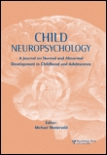
CHILD NEUROPSYCHOLOGY
Bridging Research and Practice for Child HealthCHILD NEUROPSYCHOLOGY, an esteemed journal published by Routledge Journals, Taylor & Francis Ltd, focuses on the intricate interplay between neurological and psychological development in children. With an ISSN of 0929-7049 and an E-ISSN of 1744-4136, this journal has been a pivotal resource in the field since 1995, catering to researchers, clinicians, and educators alike. The journal holds a prestigious position in the Q2 quartile across key categories such as Developmental and Educational Psychology, Neuropsychology and Physiological Psychology, and Pediatrics, Perinatology, and Child Health as of 2023. Ranking in the 74th percentile for Pediatrics and reflecting its significant contributions, CHILD NEUROPSYCHOLOGY aims to publish groundbreaking studies that expand understanding of neurodevelopmental disorders and inform clinical practices. While not open access, the journal ensures high-quality, peer-reviewed articles that are vital for advancing knowledge and improving outcomes in child health and education. As it continues to bridge the gap between research and practice, CHILD NEUROPSYCHOLOGY remains an essential resource for those dedicated to advancing the science of child cognitive and emotional development.

Cuadernos de Neuropsicologia-Panamerican Journal of Neuropsychology
Unveiling the complexities of cognitive disorders.Cuadernos de Neuropsicologia-Panamerican Journal of Neuropsychology is a premier open access journal dedicated to advancing the field of neuropsychology through the dissemination of high-quality research. Published by NEUROPSICOLOGIA CL in Chile, this journal has been a vital resource for the academic community since its inception in 2007. With a focus on various aspects of neuropsychological theory and practice, the journal aims to bridge the gap between research and application, addressing key issues in diagnosis, treatment, and rehabilitation of cognitive disorders. By providing a platform for innovative studies, systematic reviews, and compelling case reports, Cuadernos de Neuropsicologia plays an instrumental role in shaping the future of neuropsychology in the Pan-American region and beyond. Researchers, clinicians, and students alike will find this journal invaluable for staying informed on the latest trends and findings in their field.
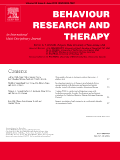
BEHAVIOUR RESEARCH AND THERAPY
Advancing the Science of Behavior and Healing.Behaviour Research and Therapy, published by Pergamon-Elsevier Science Ltd, stands as a pivotal journal in the realm of clinical, developmental, and cognitive psychology. With a distinguished history dating back to 1963, this esteemed journal has continuously provided a vital platform for groundbreaking research focused on understanding and treating psychological disorders. It holds an impressive impact factor and is categorized in the Q1 quartile across multiple domains including Clinical Psychology, Developmental and Educational Psychology, Experimental and Cognitive Psychology, and Psychiatry and Mental Health. With its Scopus ranking placing it in the top percentiles of its field, Behaviour Research and Therapy serves as an essential resource for researchers, professionals, and students seeking to remain at the forefront of psychological science. While it operates under a traditional subscription model rather than an open access framework, its contributions are invaluable for advancing our understanding of behavior and therapeutic interventions.

COGNITIVE NEUROPSYCHOLOGY
Exploring the Intersection of Cognition and Neural ScienceCOGNITIVE NEUROPSYCHOLOGY, published by ROUTLEDGE JOURNALS, TAYLOR & FRANCIS LTD, is a premier academic journal that has established itself as a vital resource in the fields of cognitive neuroscience, neuropsychology, and psychology since its inception in 1984. With an esteemed impact factor that reflects its significance within the academic community, this journal is classified in the Q1 category for Arts and Humanities (miscellaneous) and Q2 in various other fields, including Cognitive Neuroscience and Developmental Psychology, based on the latest evaluation of 2023. COGNITIVE NEUROPSYCHOLOGY provides a platform for the dissemination of innovative research findings and theoretical advancements that deepen our understanding of cognitive processes and behavior in relation to neural systems. The journal also boasts a robust Scopus ranking, ensuring that articles published are of the highest caliber. Though it follows a traditional publishing model, the journal's commitment to rigorous peer review guarantees that it remains an authoritative voice for researchers, professionals, and students devoted to advancing knowledge in these critical areas of study.
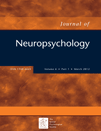
Journal of Neuropsychology
Unraveling the Complexities of the Mind-Brain ConnectionThe Journal of Neuropsychology, published by WILEY, is a premier academic journal dedicated to advancing the field of neuropsychology and its related disciplines. With a focus on behavioral and cognitive neuroscience, this journal presents cutting-edge research that informs our understanding of psychological functions and their underlying neural mechanisms. Operating with an impressive impact factor representative of its rigorous peer-review process, the journal has established itself within the Q2 and Q3 quartiles of multiple relevant categories, including Neuropsychology and Physiological Psychology. Researchers will find the ISSN 1748-6645 and E-ISSN 1748-6653 useful for academic referencing as they explore articles that span innovative methodologies and insights into neurological conditions. Published continuously since 2007, the Journal of Neuropsychology stands as a vital resource for professionals and students alike, fostering scholarly discourse and knowledge exchange in neuropsychological research.

Journal of Cognitive Enhancement
Fostering Collaboration for Enhanced Mental Health Insights.Journal of Cognitive Enhancement, published by SpringerNature, is a premier academic platform dedicated to advancing knowledge in the fields of Cognitive Neuroscience, Behavioral Neuroscience, and Experimental Psychology. With an electric combination of rigorous research and innovative practice, this journal has established itself as an essential resource for researchers, professionals, and students interested in understanding the mechanisms behind cognitive enhancement and its implications for mental health and cognitive function. As of 2023, it is recognized in the Q2 and Q3 quartiles across several categories, demonstrating its solid impact in the academic community, particularly with an impressive Scopus ranking of #27/76 in Neuropsychology and Physiological Psychology. Operating in a competitive landscape, the Journal of Cognitive Enhancement fosters open dialogue and collaboration through valuable contributions to cognitive research, facilitating insights that are crucial for practical applications in clinical and educational settings. While specific open access options are currently not defined, we encourage all interested scholars to explore the rich database of published works dating from 2017 to 2024, contributing to this dynamic field of study.

Neuropsychological Trends
Pioneering Insights into Cognitive and Psychological ConditionsNeuropsychological Trends is a prominent, open-access journal published by LED EDIZIONI UNIV, based in Italy. Since its inception in 2007, the journal has dedicated itself to advancing research in the fields of neuropsychology and cellular neuroscience, catering specifically to the evolving trends shaping these disciplines. With the ISSN 1970-321X and an E-ISSN of 1970-3201, the journal provides a platform for multidisciplinary dialogue and exploration of neuropsychological phenomena. While ranked in the fourth quartile for both Cellular and Molecular Neuroscience and Neuropsychology and Physiological Psychology categories in 2023, the journal encourages innovative research that aims to enhance understanding and treatment of cognitive and psychological conditions. The convergence of years from 2011 to 2024 marks a significant period for contributions that inform clinical practice and theoretical frameworks. As researchers, professionals, and students engage with cutting-edge studies and reviews, Neuropsychological Trends serves as a vital resource for staying informed and fostering collaboration in the neuropsychological community.
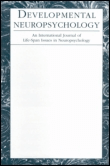
DEVELOPMENTAL NEUROPSYCHOLOGY
Illuminating Developmental Pathways in NeuropsychologyDEVELOPMENTAL NEUROPSYCHOLOGY (ISSN: 8756-5641; E-ISSN: 1532-6942) is a pivotal peer-reviewed journal published by ROUTLEDGE JOURNALS, TAYLOR & FRANCIS LTD in the United Kingdom. Since its inception in 1985, this esteemed journal has been dedicated to advancing the understanding of developmental processes that influence neuropsychological outcomes in children and adolescents. With a focus on the integration of psychological and neuropsychological perspectives, it serves as a vital resource for researchers, clinicians, and educators alike. The journal's current impact factor and its placement in the third quartile for both Developmental and Educational Psychology and Neuropsychology categories underscore its significance in the field, as it ranks in the 45th percentile in both Scopus ranks. While DEVELOPMENTAL NEUROPSYCHOLOGY does not offer open access, it presents crucial research findings and theoretical advancements that cater to professionals seeking to deepen their knowledge and application of developmental neuropsychology until 2024. By fostering dialogue among scholars and practitioners, this journal contributes meaningfully to the ongoing evolution of clinical practices and educational strategies targeting neurodevelopmental trajectories.

Neuropsychologia
Fostering Knowledge in Behavioral and Cognitive NeuroscienceNeuropsychologia, published by PERGAMON-ELSEVIER SCIENCE LTD, is a premier journal that delves into the intersections of psychology and neuroscience, specifically focusing on behavioral and cognitive processes. Since its inception in 1963, this esteemed journal has been a vital platform for researchers, professionals, and students, showcasing innovative studies and advancements in the fields of Behavioral Neuroscience, Cognitive Neuroscience, and Experimental Psychology. With a commendable impact factor, placing it in the Q2 category across multiple disciplines, Neuropsychologia is recognized for its contribution to the scientific community, ranking among the top journals in both Experimental and Cognitive Psychology and Neuroscience. The journal's commitment to excellence is evident in its rigorous peer-review process and its mission to disseminate cutting-edge research, making it an invaluable resource for those seeking to expand their knowledge and insights in neuropsychology. For further reading, the journal is accessible in both print and digital formats, ensuring that researchers can easily engage with the latest findings and theoretical advancements in this dynamic field.